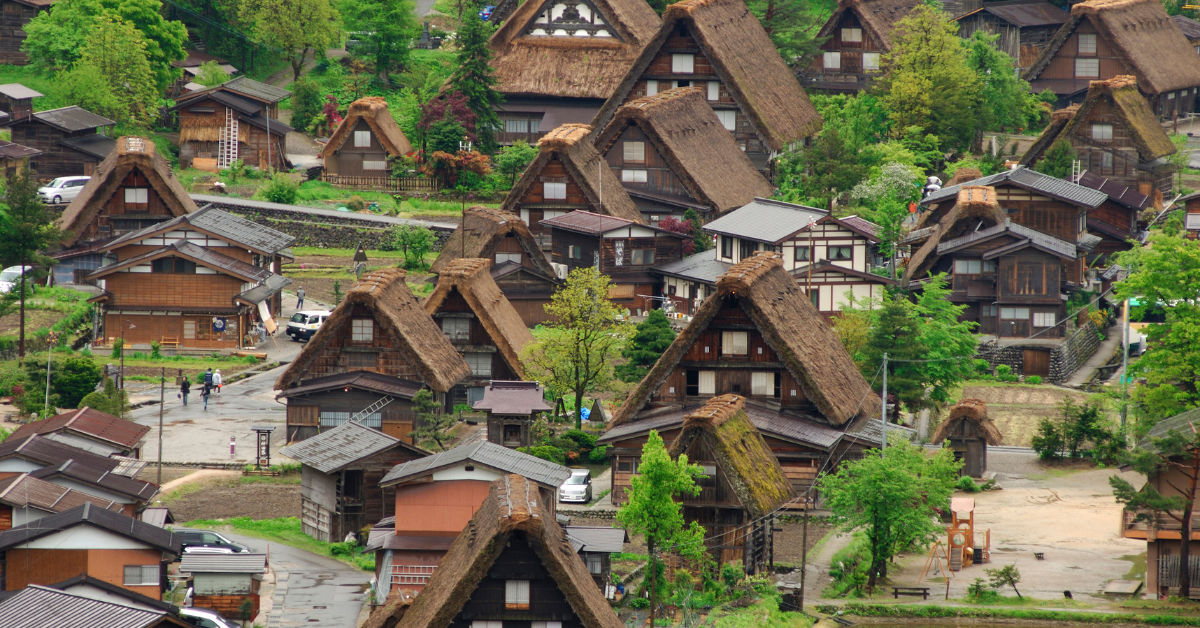Shirakawa-go and Gokayama are picturesque villages often called Japan’s original landscape. For Japanese people, their charm lies not only in their beauty but also in the living traditions and culture that continue to thrive there.
- Overview and History of Gassho-style Villages
- First Impressions Felt by Japanese Visitors
- Post-visit Impressions and Memorable Experiences
- Architectural Style and Wisdom of Daily Life
- Cultural Value Felt by Japanese People
- Differences Between Japanese and Foreign Visitors’ Impressions
- Recommended Experiences When Visiting
- Conclusion
Overview and History of Gassho-style Villages
The Gassho-style houses of Shirakawa-go and Gokayama are characterized by steep thatched roofs designed for life in heavy snowfall areas. The roof’s slope is a clever adaptation that lets snow slide off naturally, and the interior is as tall as a three-story building, used for silkworm breeding and storing grain.
This architectural style has continued since the Edo period, maintained through the cooperation of local communities, and villagers still carry out repair work today.
Features of Gassho-style Houses
| Feature | Description |
|---|---|
| Roof Angle | About 45 degrees to avoid snow removal |
| Materials | Thatch and timber |
| Purpose | Living, sericulture, storage |
| Durability | Lasts decades with regular re-thatching |
| Construction Method | Built through communal village labor |
First Impressions Felt by Japanese Visitors
Many visitors are first impressed by the unity of the landscape. With almost no modern buildings in sight, it looks like a scene straight out of an old folktale. In winter, the village is covered in snow; in spring, water-filled rice fields mirror the roofs; in summer, it is surrounded by lush greenery; and in autumn, red leaves accompany golden rice fields.
Visitors are also drawn to the “quietness” and “slower passage of time” unique to this area.
Seasonal Attractions
| Season | Main Scenery | Japanese Impressions |
|---|---|---|
| Spring | Rice fields and lingering snow on the mountains | Peaceful and gentle scenery |
| Summer | Green mountains and blue skies | Cool and refreshing atmosphere |
| Autumn | Red leaves and rice fields | Moved by the beauty of colors |
| Winter | Snow-covered village | Fairy-tale-like scenery |
Post-visit Impressions and Memorable Experiences
Common impressions among Japanese tourists include the feeling that “tradition is alive here.” Even with tourism, the residents’ lifestyle and culture are preserved, and visitors appreciate enjoying handmade farm produce and local cuisine.
The nighttime light-up events are especially popular, with many describing the contrast of snow and light as magical.
Common Impressions and Reasons
| Impression | Reason |
|---|---|
| Tradition remains | Locals still live here in their daily lives |
| Beautiful scenery | Changing faces through the four seasons |
| Delicious food | Local ingredients and farm-to-table culture |
| Clear air | Mountainous natural environment |
| Photogenic | Unique architecture and scenery |
Architectural Style and Wisdom of Daily Life
The structure of Gassho-style houses contains not just beauty but also practical wisdom. In winter, the heavy snow cover is managed by the roof’s steep slope, and the attic space is designed to keep indoor temperatures stable for work and storage.
Living Wisdom in Gassho-style Houses
| Wisdom | Effect |
|---|---|
| Steep roof | Snow slides off naturally |
| Thick thatch | Improves insulation |
| Large beams | Increases durability |
| Use of attic | Sericulture and drying storage |
| Community re-thatching | Efficient upkeep |
Cultural Value Felt by Japanese People
For Japanese people, Shirakawa-go and Gokayama are not just tourist spots—they are places that inspire pride as cultural heritage. School trips and family visits here offer children opportunities to learn about Japan’s history and regional ingenuity.
Elements of Cultural Value
| Element | Description |
|---|---|
| Historical Value | Village structures from the Edo period |
| Architectural Techniques | Traditional construction without nails |
| Living Culture | Self-sufficient lifestyle |
| Community Spirit | Village-wide cooperation |
| Educational Value | History education for children |
Differences Between Japanese and Foreign Visitors’ Impressions
Interestingly, Japanese and foreign visitors are impressed by different aspects. Japanese people are moved by “nostalgia” and “scenery from the past,” while foreign visitors tend to value “uniqueness” and “photogenic spots.”
Comparison of Impressions
| Visitors | Main Impressions |
|---|---|
| Japanese | Nostalgia, tranquility, cultural pride |
| Foreign | Uniqueness, distinctive architecture, photogenic views |
Recommended Experiences When Visiting
When visiting, it is recommended to go beyond simply seeing the scenery and also experience the local lifestyle. Farming activities, local cooking classes, and washi papermaking offer opportunities to feel the culture firsthand.
Recommended Experiences and Their Appeal
| Experience | Appeal |
|---|---|
| Farming activities | Experience local life |
| Cooking class | Learn local cuisine |
| Washi papermaking | Try traditional crafts |
| Staying in a minshuku | Interact with residents |
| Winter light-up | Enjoy magical scenery |
Conclusion
The Gassho-style villages of Shirakawa-go and Gokayama are symbols of Japan’s original landscape and culture. Their charm lies not only in the beauty of their scenery and buildings but also in the way of life and community spirit that thrive there. Visiting these places allows one to feel the changing nature of the four seasons and the wisdom of tradition, while also reaffirming a sense of cultural pride as a Japanese person.






